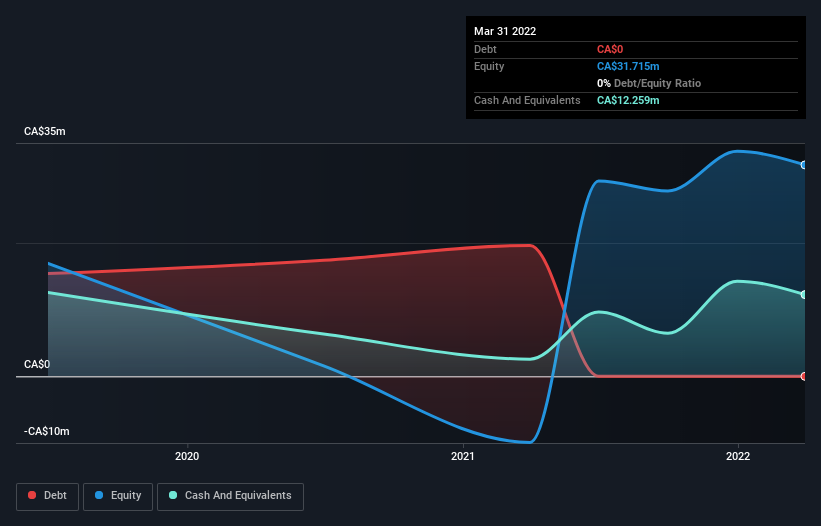- Canada
- /
- Retail Distributors
- /
- CNSX:HMBL
Here's Why We're Watching Humble & Fume's (CSE:HMBL) Cash Burn Situation

We can readily understand why investors are attracted to unprofitable companies. For example, although Amazon.com made losses for many years after listing, if you had bought and held the shares since 1999, you would have made a fortune. Nonetheless, only a fool would ignore the risk that a loss making company burns through its cash too quickly.
So, the natural question for Humble & Fume (CSE:HMBL) shareholders is whether they should be concerned by its rate of cash burn. In this article, we define cash burn as its annual (negative) free cash flow, which is the amount of money a company spends each year to fund its growth. Let's start with an examination of the business' cash, relative to its cash burn.
Check out our latest analysis for Humble & Fume
How Long Is Humble & Fume's Cash Runway?
A company's cash runway is the amount of time it would take to burn through its cash reserves at its current cash burn rate. In March 2022, Humble & Fume had CA$12m in cash, and was debt-free. Importantly, its cash burn was CA$9.2m over the trailing twelve months. So it had a cash runway of approximately 16 months from March 2022. While that cash runway isn't too concerning, sensible holders would be peering into the distance, and considering what happens if the company runs out of cash. The image below shows how its cash balance has been changing over the last few years.

How Well Is Humble & Fume Growing?
It was quite stunning to see that Humble & Fume increased its cash burn by 277% over the last year. On top of that, the fact that operating revenue was basically flat over the same period compounds the concern. In light of the above-mentioned, we're pretty wary of the trajectory the company seems to be on. In reality, this article only makes a short study of the company's growth data. This graph of historic earnings and revenue shows how Humble & Fume is building its business over time.
How Hard Would It Be For Humble & Fume To Raise More Cash For Growth?
Since Humble & Fume has been boosting its cash burn, the market will likely be considering how it can raise more cash if need be. Issuing new shares, or taking on debt, are the most common ways for a listed company to raise more money for its business. Many companies end up issuing new shares to fund future growth. We can compare a company's cash burn to its market capitalisation to get a sense for how many new shares a company would have to issue to fund one year's operations.
Humble & Fume's cash burn of CA$9.2m is about 25% of its CA$37m market capitalisation. That's not insignificant, and if the company had to sell enough shares to fund another year's growth at the current share price, you'd likely witness fairly costly dilution.
How Risky Is Humble & Fume's Cash Burn Situation?
On this analysis of Humble & Fume's cash burn, we think its cash runway was reassuring, while its increasing cash burn has us a bit worried. Looking at the factors mentioned in this short report, we do think that its cash burn is a bit risky, and it does make us slightly nervous about the stock. Taking a deeper dive, we've spotted 3 warning signs for Humble & Fume you should be aware of, and 1 of them doesn't sit too well with us.
If you would prefer to check out another company with better fundamentals, then do not miss this free list of interesting companies, that have HIGH return on equity and low debt or this list of stocks which are all forecast to grow.
Valuation is complex, but we're here to simplify it.
Discover if Humble & Fume might be undervalued or overvalued with our detailed analysis, featuring fair value estimates, potential risks, dividends, insider trades, and its financial condition.
Access Free AnalysisHave feedback on this article? Concerned about the content? Get in touch with us directly. Alternatively, email editorial-team (at) simplywallst.com.
This article by Simply Wall St is general in nature. We provide commentary based on historical data and analyst forecasts only using an unbiased methodology and our articles are not intended to be financial advice. It does not constitute a recommendation to buy or sell any stock, and does not take account of your objectives, or your financial situation. We aim to bring you long-term focused analysis driven by fundamental data. Note that our analysis may not factor in the latest price-sensitive company announcements or qualitative material. Simply Wall St has no position in any stocks mentioned.
About CNSX:HMBL
Humble & Fume
Humble & Fume Inc. engages in the wholesale of cannabis related products and accessories in Canada and the United States.
Excellent balance sheet and slightly overvalued.
Market Insights
Community Narratives


